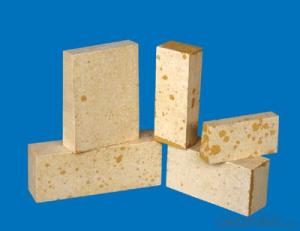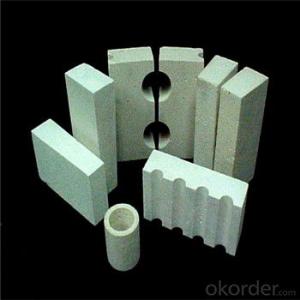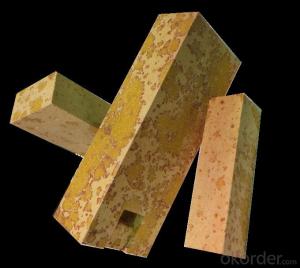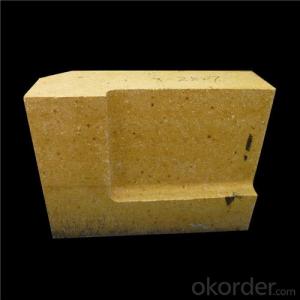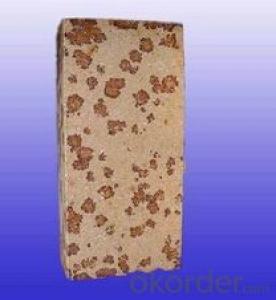Silica Brick for Glass Kiln
- Loading Port:
- Qingdao
- Payment Terms:
- TT OR LC
- Min Order Qty:
- 100 PCS
- Supply Capability:
- 50000 PCS/month
OKorder Service Pledge
OKorder Financial Service
You Might Also Like
Specifications
1.Silica brick manufature.
2.High refractoriness under load.
3.High heat conductivity.
4.Good thermal shock resistance
Quick Details
Place of Origin: Shandong, China (Mainland)
Shape: Brick
Material: Other
SiO2 Content (%): >96%
CaO Content (%): <2.2%
Refractoriness (Degree): 1770°< Refractoriness< 2000°
Brand Name: Trust Kim
Specifications
The silica bricks for HBS Silica fire brick for coke oven High density silica fire brick Semi-silics fire brick for coke oven
1.Silica brick manufature. 2.High refractoriness under load. 3.High heat conductivity. 4.Good thermal shock resistance.
Tech Data
- Q: Common bond brick?
- Lime should contain a lot of active CaO, I decompose CaCO3 and MgCO3 not more than 5%, Al2O3+Fe2O3+SiO2 no more than 5%. When the content of large particles, burned Ca-CO3 and over burned lime, the product produced caves, affecting the quality of products.
- Q: Why will expand when heated brick
- Because the production of raw materials are silica brick, brick with SiO2 content of not less than 95% of silica as raw materials, adding mineralizer and binder, through mixing, molding, drying, sintering and other processes in the system
- Q: The specific content is what gb/t2608-2012 brick
- The provisions of the brick classification, technical requirements, test methods,
- Q: The introduction of silica brick
- Brick refers to the content of more than 93% products SiO2. Brick with SiO2 content of not less than 96% of silica as raw materials, adding mineralizer and binder, through mixing, molding, drying, sintering and other processes in the system. The higher the content of SiO2 in silica raw material, the higher the refractoriness of the product. According to the use of brick varieties, divided into: coke oven silica brick, brick for hot blast stove, electric stove with brick, brick for glass furnaces. According to the transformation is divided into: standard bricks, tiles, bricks and general special brick etc..
- Q: What is acid refractory?
- Acid refractory material usually refers to refractories with SiO2 content greater than 93%. Its main characteristic is that it can resist acid slag corrosion at high temperature, but it is easy to react with alkaline slag.
- Q: Why is the new trend of the high thermal conductivity of silica brick
- The use of high thermal conductivity of silica brick, reducing coke fuel consumption, reduce emissions of pollutants such as NOx, with considerable economic benefits and social benefits, is the future direction of the new technology of using coke oven refractory.
- Q: Semisilica brick, clay brick, high alumina brick and what is the difference?
- The share of A12O3 and SiO2 is different
- Q: Which material is good for furnace refractory?
- Neutral refractory is mainly composed of alumina, chromium oxide or carbon. Corundum products containing more than 95% of alumina are a kind of high quality refractory materials with a wide range of uses. Chrome brick with chromium oxide as its main component has good corrosion resistance, but its thermal shock resistance is poor, and its deformation temperature is lower at high temperature. Carbon refractories with carbon bricks, graphite and silicon carbide products, low coefficient of thermal expansion, high thermal conductivity, good thermal shock resistance, high strength, resistance to acid and salt corrosion, especially weak acid has good resistance, without wetting of the metal and slag, light. It is widely used as lining material of high temperature, and also used as lining of autoclave in petroleum and chemical industry.
- Q: Can iron oxide be used as refractory material?
- Iron oxide can not be used as refractory material, but it can be used as refractory additive. Iron oxide can be used as pigment
- Q: How to improve the thermal conductivity of the coke silicabrick rate?
- To improve the thermal conductivity of silica brick for coke oven rate method:Manufacture of high density and high thermal conductivity of silica brick, adding additives such as CuO, Cu2O, TiO2, Fe2O3, (FeO), can improve the thermal conductivity of silica brick.
Send your message to us
Silica Brick for Glass Kiln
- Loading Port:
- Qingdao
- Payment Terms:
- TT OR LC
- Min Order Qty:
- 100 PCS
- Supply Capability:
- 50000 PCS/month
OKorder Service Pledge
OKorder Financial Service
Similar products
Hot products
Hot Searches
Related keywords

